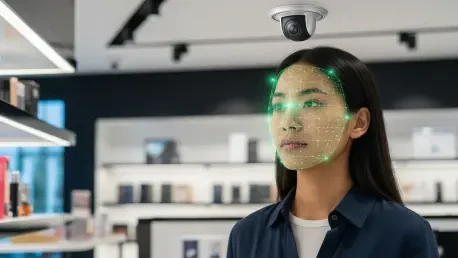Setting the Stage for Retail Security Innovation
Imagine walking into a supermarket, unaware that a sophisticated system is scanning your face to ensure store safety and smooth transactions, a reality now for shoppers at Sheng Siong in Singapore. As a leading supermarket chain, Sheng Siong has embraced this technology to combat the growing challenge of retail theft, with shop theft cases rising by 4.2% in the first half of this year compared to last year. This alarming trend has pushed the industry toward adopting cutting-edge solutions like facial recognition technology to fight crime and enhance operational efficiency. Sheng Siong’s pioneering deployment of this technology offers a compelling case study to explore how digital innovation is reshaping retail security.
This review delves into the specifics of facial recognition as implemented by Sheng Siong, a major player in Singapore’s retail landscape. Since its rollout in approximately 50 of its 83 outlets starting last year, the supermarket chain has integrated this technology with existing security systems to address persistent issues like shoplifting and payment failures. The following sections analyze the core features, performance metrics, real-world applications, and broader implications of this transformative tool in the retail sector.
Core Features and Performance Analysis
Automated Shoplifter Detection
One of the standout capabilities of Sheng Siong’s facial recognition system is its ability to automatically identify known shoplifters as they enter any store. Unlike the outdated method of manually reviewing surveillance footage and printing suspect photos, this technology instantly flags individuals with a history of theft, alerting store managers to monitor their activities. The seamless integration with existing security cameras ensures that the process is both discreet and efficient, minimizing disruption to regular operations.
The impact on store safety has been remarkable. Data indicates that the number of apprehended shoplifters has doubled, rising from an average of four to eight per store annually since the system’s introduction. This significant improvement underscores the technology’s precision in tracking suspects until they are handed over to law enforcement, after which their data is promptly removed from the system to maintain compliance with privacy standards.
Resolving Payment Discrepancies
Beyond security, facial recognition at Sheng Siong addresses financial losses stemming from failed payment transactions. Often, customers leave the store unaware that their card payments did not process due to network glitches or swiping errors, creating a gap in revenue. Previously, such incidents led to monthly losses of around $10,000 across all outlets, a substantial hit to the bottom line.
With the new system in place, staff can identify these customers upon their return and approach them to settle the outstanding amount. This has slashed monthly losses dramatically to just $1,500, showcasing the technology’s versatility. More importantly, it enhances customer service by facilitating amicable resolutions, turning potential conflicts into opportunities for positive engagement.
Real-World Impact at Sheng Siong
Sheng Siong’s deployment of facial recognition across half of its stores since last year marks a significant step in modernizing retail security. With plans to extend this technology to all 83 outlets in the coming months, the chain is setting a precedent for how supermarkets can leverage digital tools to tackle dual challenges. The system not only deters shoplifting but also mitigates financial discrepancies, creating a safer and more efficient shopping environment.
A unique aspect of this implementation is the focus on data management. Once a suspect is apprehended by police, their information is erased from the database, reflecting a commitment to ethical use of technology. This balance between functionality and responsibility highlights Sheng Siong’s approach as a model for other retailers looking to adopt similar systems.
The broader context of retail theft in Singapore further validates this initiative. Supported by the Singapore Police Force’s Shop Theft Awareness for Retailers program, Sheng Siong’s efforts align with a national push to curb rising crime rates. Other major retailers, such as FairPrice and Watsons, are now encouraged to follow suit, indicating a potential industry-wide shift toward advanced security measures.
Challenges and Privacy Considerations
While the benefits of facial recognition are evident, privacy concerns remain a critical point of discussion. Even though no explicit public objections have surfaced at Sheng Siong, the use of such technology inherently raises questions about data collection and surveillance. Customers may wonder how their information is stored and whether it could be misused, even in a controlled environment like a supermarket.
To address these potential sensitivities, Sheng Siong has taken proactive steps toward transparency. Posters displayed in all equipped outlets inform shoppers about the presence of surveillance cameras enhanced with facial recognition capabilities. This measure aims to build trust by ensuring awareness, though it also underscores the need for clear regulatory guidelines as adoption expands across the retail sector.
An additional layer of complexity lies in public perception. As more retailers integrate facial recognition, the balance between security and individual rights will likely come under greater scrutiny. Retailers must remain vigilant in communicating their policies to avoid alienating customers who value privacy alongside convenience.
Industry Trends and Future Potential
The rise of retail theft has catalyzed a broader trend in security technology adoption across Singapore. With shop theft cases showing a steady increase, the industry is turning to digital solutions to safeguard assets and streamline operations. Facial recognition stands out as a frontrunner, backed by endorsements from law enforcement and programs designed to educate retailers on theft prevention strategies.
Looking ahead, the technology’s potential extends beyond current applications at Sheng Siong. Future advancements could include improved accuracy in identifying individuals under varying conditions, such as low lighting or obscured faces. Integration with other retail management systems, like inventory tracking or personalized marketing, could also unlock new efficiencies, though such expansions must be carefully weighed against privacy implications.
The influence of Sheng Siong’s success may inspire a ripple effect among competitors. If full rollout across all outlets proves as effective as initial results suggest, facial recognition could become a standard in Singapore’s retail landscape over the next few years, from 2025 to 2027. This shift would redefine industry benchmarks for security and customer experience, positioning technology as a cornerstone of modern retail strategy.
Final Verdict and Path Forward
Reflecting on Sheng Siong’s journey with facial recognition since its rollout last year, the technology has proven to be a game-changer in bolstering security and curbing financial losses. The doubling of shoplifter apprehensions and the drastic reduction in payment-related losses highlight its effectiveness in addressing core retail challenges. As a benchmark for innovation, this implementation demonstrates how digital tools can transform traditional store operations.
Moving forward, retailers considering similar systems should prioritize transparency by clearly communicating surveillance practices to customers. Establishing robust data protection policies will be essential to maintain trust as adoption grows. Additionally, collaboration with regulatory bodies could help shape guidelines that balance security needs with privacy rights.
For Sheng Siong and the broader industry, the next step involves exploring enhancements to facial recognition, such as real-time analytics or cross-platform integration, to further optimize performance. As Singapore’s retail sector navigates rising theft rates, sustained investment in technology, coupled with ethical considerations, will be key to building a secure and customer-centric future.









